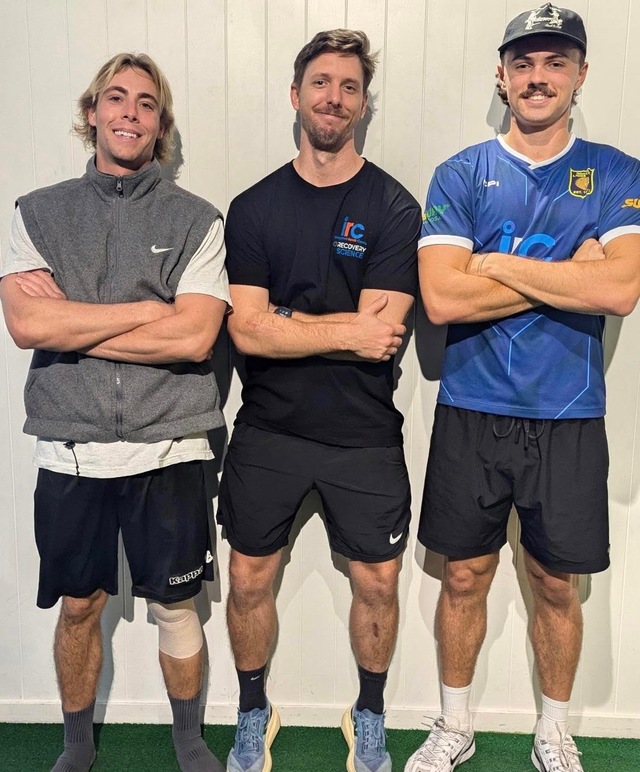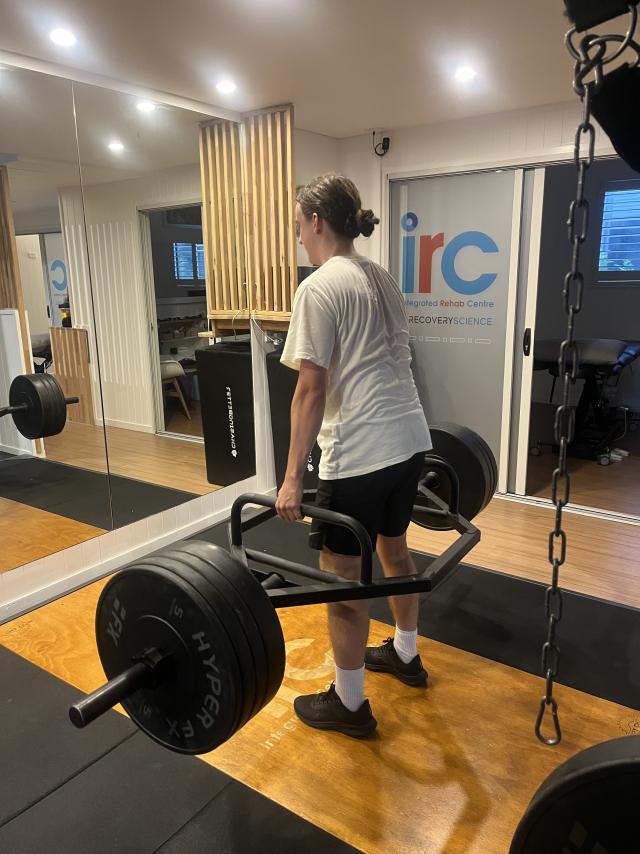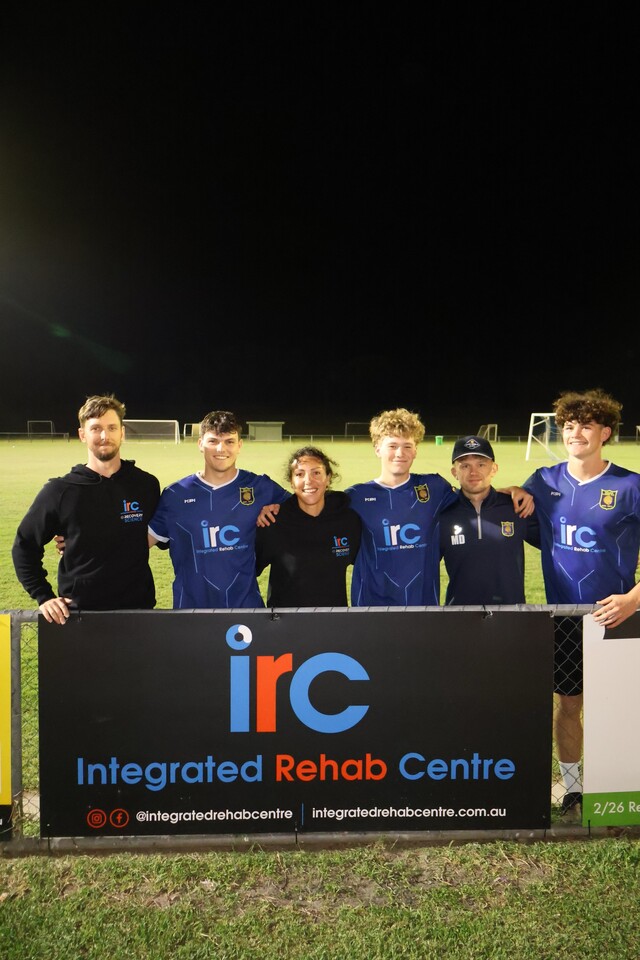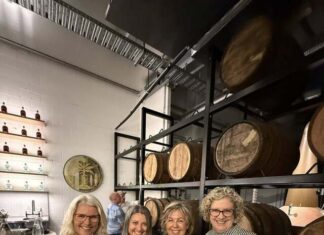When Olly Blackmore stepped back onto the pitch earlier this year, it marked more than just a return to football—it was the culmination of a long and painful journey. Just as fate would have it, that same day, teammate Sam Taylor suffered a devastating ACL injury of his own. Two players, one cruel coincidence, and a shared path toward recovery—made possible by a game-changing partnership between Noosa Lions Football Club and the Integrated Rehabilitation Centre (IRC).
This collaboration, now in its second year, was spearheaded by Lions player and IRC Sports and Exercise Scientist, Matt Upton. Since joining IRC two and a half years ago, Upton has played a key role in developing individualised return-to-play programs across multiple codes in Noosa. His primary mission: to turn injury recovery into an opportunity for players to return not just fit, but stronger, smarter, and more resilient than before.
“I always tell players: injury gives you the chance to really understand your body,” Upton says. “And that understanding makes you a better athlete.”
Ollie Blackmore is living proof of that mantra. Having suffered a ruptured ACL during training in July 2023—just two years after enduring an 11-month layoff from hip surgery—Blackmore could have been forgiven for thinking his football career was cursed.
“Back in 2021, there wasn’t a partnership with IRC. I was really on my own,” says Blackmore. “This time around, it was completely different.”
Two weeks post-surgery, he began working twice a week with physiotherapist Scott Findlater at IRC. The focus in those early months was on mobility, balance, and strength. But perhaps more importantly, the work was tailored to Blackmore as an individual—helping him regain not only function, but confidence.
As a Barista by day, Blackmore bonded with Findlater over a shared love of coffee. “It’s the personal touches that helped the most,” he reflects. “When you’re going through a tough time, that connection matters.”
Enter Matt Upton, who later stepped in to guide Blackmore through the next phase: regaining match fitness. With structured testing, data tracking, and gradual reintegration to training loads via GPS monitoring, Upton became the vital link between recovery room and football field.
“He was the bridge between the trauma of the injury and the joy of playing again,” says Blackmore. “He told me I’d come back a better player—and I believe I have.”
That same process is now being followed by Sam Taylor, who ruptured his ACL in June while finishing his university degree in exercise physiology. Despite recognising the severity of the injury immediately, he was forced to delay surgery until September to complete his University placement. His recovery since then has been meticulous.
Taylor worked closely with Findlater during his early rehabilitation, including months of non-weight-bearing exercises, followed by careful reconditioning. Using asymmetry data to monitor the strength differences between his injured and uninjured limbs, the IRC team were able to ensure a safe and symmetrical recovery.
“We had to get that imbalance below 10% before I could progress,” says Taylor. “It was fascinating to see the numbers reflect how my body was rebuilding.”
Nine months later, Taylor started running and is now kicking a ball again, and back training with the squad, though his return to play will be timed carefully by Upton.
“The last thing we want is to rush him back and risk re-injury,” says Upton. “It’s about meeting milestones, both Ollie and Sam needed hamstring grafts to repair their ACLs, but no two recoveries are ever the same,” says Upton. “Each athlete’s journey is different, and that’s why we individualise everything—from goal-setting to testing protocols.”
Taylor’s personal goal is a light-hearted one: to score before the end of the season and avoid the dreaded “nudie run”—a club tradition for any outfield player who fails to score all year. But beneath the humour lies a steely determination to return better than ever.
There’s also a growing sense of camaraderie and shared purpose at Noosa Lions. Blackmore, now one of the squad’s most experienced rehab veterans, has taken an active role in supporting both Taylor and new ACL casualty Cole Campbell, forming a circle of mentorship that complements the clinical care at IRC. Campbell had surgery three weeks ago and is full of praise for how he has been looked after by IRC.
“The players are looking after each other, as much as the IRC staff are,” says Noosa Coach, Michael Williams. “It’s become part of the club culture and something we need to build on and develop to support all of our players.”
It’s a far cry from the early days when injury meant a lonely road and uncertain outcome. With IRC’s whole-person approach—combining physio, conditioning, nutrition, and emotional support—the Lions now have a clear roadmap from setback to comeback.
“A lot’s changed at Noosa Lions since the days of the Bobby Chalmers spray,” Williams laughs. “Since we started working with Coastal Recovery, there’s been a real shift in how we approach recovery. It’s not just about strapping on some ice after a match—it’s about understanding our bodies better and being proactive.
“Football at any level takes a toll on the body,” said Noosa Lions Technical director, Matt Digwood. “This partnership with IRC ensures our players get top-level rehabilitation, tailored recovery plans, and preventative support. It’s about keeping players on the pitch and performing at their best, but also about ensuring they recover properly and avoid long-term issues.”
The partnership has already yielded impressive results, with improved return-to-play timelines and players reporting increased fitness and confidence post-rehab.
Looking ahead, IRC and Noosa Lions hope to expand their joint programs, including on-site physio for training days, junior athlete education, and integrated fitness sessions across the club. “It’s about building a culture of smart recovery and long-term health,” Upton said.









